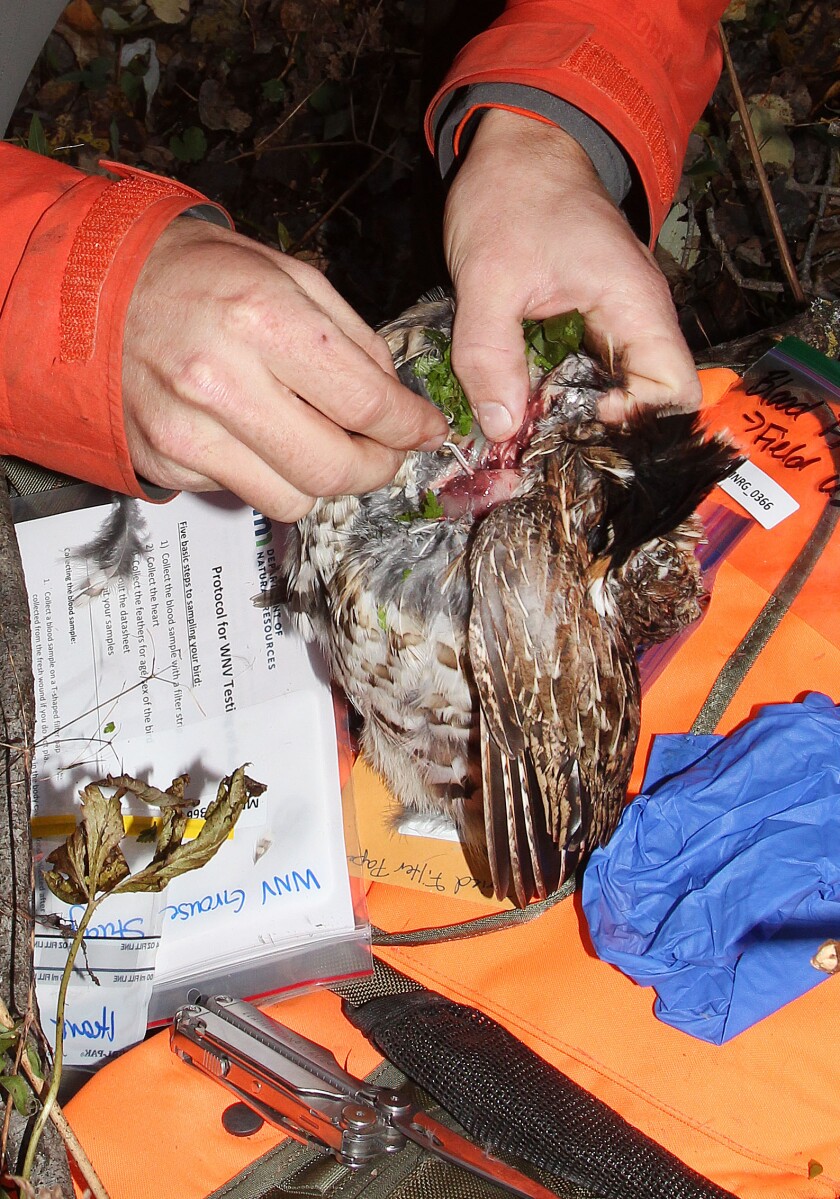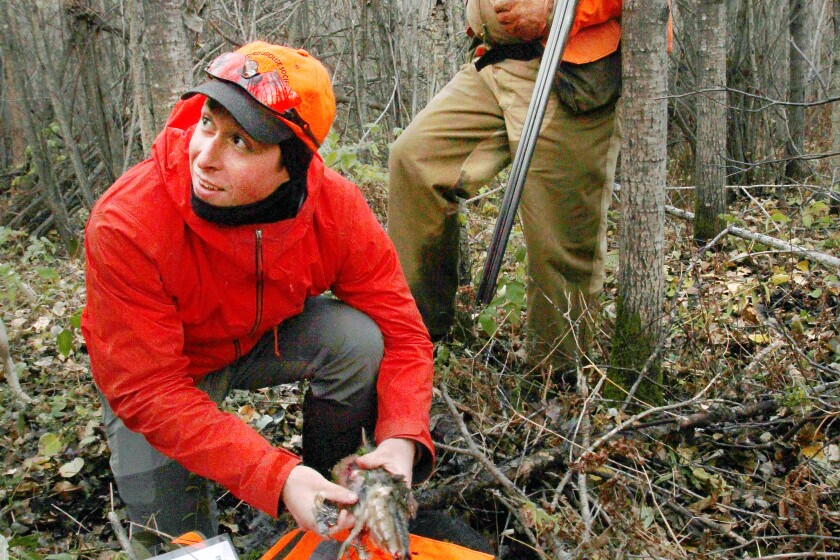CHIPPEWA NATIONAL FOREST - Jens Heig first checked the tail and rump feathers of the smallish grouse, then checked the edges of the wing feathers.
It was a juvenile bird, he concluded, a female.
ADVERTISEMENT
Then he dug into the crop, just to see what the bird had been feeding on (wild strawberry leaves) before digging into his backpack for a field test kit that looks a bit like something from CSI Northwoods.
Heig, a grouse hunting guide, is a volunteer tester for the Minnesota Department of Natural Resources this hunting season as wildlife experts try to determine what, if any impact West Nile virus is having on the state's grouse population. There are concerns that the disease may be holding grouse numbers down.
Heig carefully took a sterile blood test strip and dabbed it in the open cavity of the bird before placing it in a clean plastic bag. He then took feather samples and eventually dug into the bird to pull out its heart.
All in the name of science.
"The blood sample has to be within a half-hour of being shot, so we just do it right a way in the field,'' Heig said as his group of hunters looked on in the woods. This particular grouse had been dead less than five minutes.
The DNR wants some 400 samples from grouse shot within a 60-mile radius of Bemidji or Grand Rapids this fall. Individual hunters who submit blood and heart samples will find out this winter if their specific birds tested positive. (There's no danger in eating the meat in the meantime if the birds are properly cooked, said Charlotte Roy, grouse project leader for the Minnesota DNR.)
Hunters in Wisconsin and Michigan are taking samples as well. Overall, region-wide results should be available to the public early next summer, Roy said. If high levels of West Nile show up this year the DNR may expand the survey to more areas in 2019.
ADVERTISEMENT
West Nile virus is known to kill crows and blue jays in Minnesota, and the stuff can be transmitted from mosquitoes to humans, but so far hasn't been found in grouse here. Then again, no one has looked until now.
There's reason for concern: A Pennsylvania study found a connection between more West Nile virus and lower grouse numbers, especially in areas where grouse habitat wasn't the best. In quality habitat areas - a diverse forest with both young and old aspen and other species - the disease had less impact on grouse.
Five grouse tested positive for West Nile in Michigan last year. Some were emaciated birds that looked bad. Others appeared perfectly healthy.
After the Pennsylvania study showed problems, wildlife managers in Minnesota, Wisconsin and Michigan began to wonder if the recent, sharp downturn in grouse numbers in the Midwest may be related to the virus, leading to the region-wide testing effort this fall. (Minnesota grouse drumming was down 29 percent this spring from 2017. Harvest was down last fall 8 percent from 2016.)
"All we know now is that we need to get more information. There are too many unanswered questions,'' said Ben Jones, national president of the Ruffed Grouse Society conservation group. "But the Pennsylvania results show this is serious. We need more data from more places."
Jones said there may be two reasons why grouse in higher quality habitat fared better against West Nile. Those birds are likely in better physical shape and better able to withstand the virus. Those areas also are better suited to produce more new birds each spring, meaning populations there can bounce back quicker.
"We don't know yet how this may be impacting populations, that's why good science is needed,'' Jones said. "Maybe we'll get lucky and the virus, after a first wave of impacting grouse, maybe they will adapt to it."
ADVERTISEMENT
West Nile virus is carried by infected mosquitoes. Not all people or animals bitten by an infected mosquito will contract West Nile virus. There have been no documented cases of people contracting West Nile virus from consuming meat from infected birds Some bird species recover quickly and become tolerant to the virus while others, such as blue jays and crows, suffer high mortality rates.
West Nile virus has been found in 300 species of birds since it was first detected in the U.S. in 1999.
Grouse testers still needed
Roy said more samples are needed from hunters in the north-central part of the state. Hunters willing to assist need to pick up test kits ahead of their hunt and then collect blood samples and hearts from birds within 30 minutes of harvest. Collection kits are available at the DNR regional headquarter buildings in Bemidji and Grand Rapids. Return postage and complete instructions are included in the kits.
Researchers collected samples from birds shot at the Ruffed Grouse Society National Hunt earlier this month as are hunters at Bowen Lodge, private hunting guides and wildlife students at Bemidji State University and Itasca Community College.
More information about ruffed grouse management can be found on the DNR website at mndnr.gov/hunting/grouse. Questions about the West Nile virus study can be directed to Roy at charlotte.roy@state.mn.us .
West Nile Virus in people
ADVERTISEMENT
Cases have been reported in 48 states. There are no vaccines to prevent it or medications to treat the virus in people. Fortunately, most people infected with virus from mosquito bites don't develop symptoms. According to the Centers for Disease Control, about one in five people infected develop a fever, swelling and other symptoms. About 1 out of 150 infected people develop a serious, sometimes fatal, illness that impacts the brain. Experts urge people to reduce their risk of the virus by using insect repellent and wearing long-sleeved shirts and long pants to prevent mosquito bites. West Nile is not known to be passed from infected birds or animals to people.









